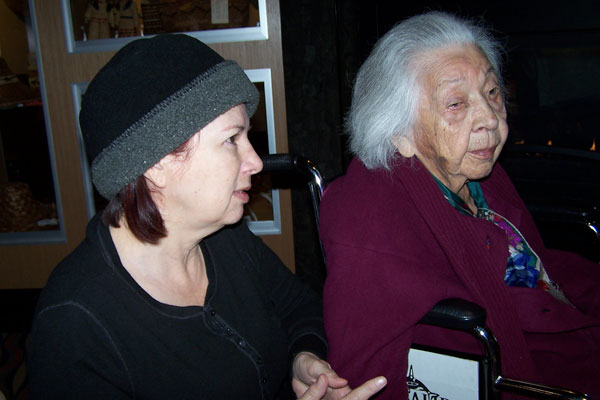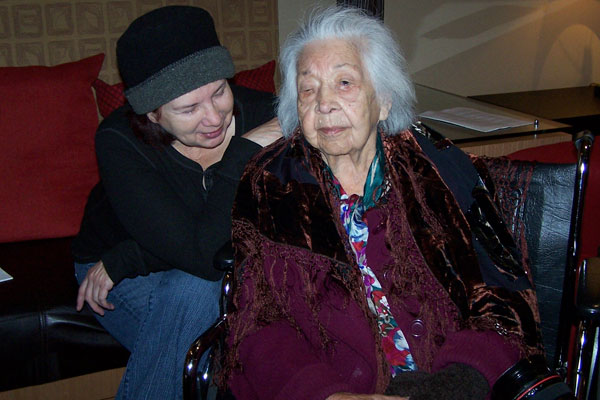Witness to 100 years of history
Published on Wed, Dec 15, 2010 by Beckye RandallRead More Communities
Bernice Williams has seen dramatic changes over the last century, both in the world at large and right here at her Tulalip home.
As an Indian child, she was teased and called derogatory names. Like other Native Americans, she was ordered to attend a state-run boarding school that forbade the use of Lushootseed, Bernice's native language, and stripped the children of their Coast Salish culture. Even as a young adult, she was not allowed to vote in Washington State. Most of her friends and family members had trouble finding jobs and many Indian families starved to death in the early days on the reservation.
One of 19 children, Bernice worked hard alongside her mother, Sarah, helping to spin wool into yarn, gathering cedar and beargrass for baskets, and preparing herbs to release their healing powers. Sarah was one of the last traditional tribal spirit dancers, and Bernice watched her mother head deep into the forest to practice the sacred healing rites after they were outlawed by the state.
Robert Sheldon, Bernice's father and a Snohomish Indian, only finished second grade, but he recognized the power of education for his children. When his son Martin came home from the Tulalip Indian School with a serious illness, Sheldon refused to send any more of his children to the boarding school, which landed him in the 6-foot by 8-foot concrete jail at Mission Beach.
Even though he objected to the culture-killing boarding school, Sheldon's children were not allowed to attend public schools because Indians weren't taxpayers. A friend of the Sheldon family, Fred Saunders, came to the rescue with his offer to sell Robert Sheldon a small house in the town of Marysville for a $1 down payment. Bernice attended the local public school through 10th grade, subsequently choosing to transfer to Chemawa, an Indian boarding school near Salem, Oregon, to enjoy the company of other native students.
A determined, bright student, Bernice was the first tribal woman to earn a college degree, graduating from Haskell Indian School with a degree in Business Administration and later attending the University of Kansas.
After marrying fellow student John Miller and moving to Tulsa, Oklahoma, Bernice suffered the trauma of losing her first two children to pneumonia in infancy. Her third child, Eleanor, also contracted the disease but pulled through. Thirteen months later and back with her Tulalip family, Bernice gave birth to Florence, one of the last babies to be born at the Tulalip Indian Hospital.
Bernice later married Walter "Sam" Alexander and bore twin sons, Warren and Harry.
"Mother was a strong taskmaster," said Harry Alexander, "very stern but loving. She kept us in line and taught us strong values. When we were older and messed up, she loved us anyway."
Altogether, Bernice Williams had seven children, although only five survived childhood. But even with a houseful of youngsters, she found time to help guide the fledgling government structure of the Tulalip Tribes.
Because of her college education and her strong values, Bernice was recruited to fill an open seat on the Tulalip Board of Directors in the mid-1930s, only the second woman to serve at that time. After being re-elected to a second term, she was tapped to manage the Tribes' first business office. Like every other job she held during her lifetime, Bernice worked hard at the $10-a-week salary.
During World War II, the Tulalip woman left the tribal office to work as a "Rosie the Riveter" at Todd Shipyards, donning a hard hat and work gloves to do the job that would be given back to men when they returned.
When times were bad and jobs were scarce, the proud woman refused to accept public assistance. Bernice and her children would pick wild berries and fruit or harvest potatoes to earn money for food. She gladly accepted unpleasant work at a fishery and a mink farm to sustain her young family.
"Any honest work is good work," Bernice told her children.
With third husband Glen Parks, Bernice helped construct a cedar home on Maplewood Road in 1965, just after retiring from her final job as tribal lease manager for the Bureau of Indian Affairs. Following Parks' death a few years later, she married fellow tribal activist Lawrence Williams.
At the age of 92, Bernice moved in with her eldest daughter Eleanor, where she still resides. Her granddaughter Linda Williams helps care for the nearly-deaf Bernice, explaining that she had "run off" many other caretakers with her strong will and independent temperament.
As hundreds of her friends and family members gathered to celebrate Bernice Williams' 100th birthday at a gathering Dec. 12 at the Tulalip Resort Casino, her children and grandchildren helped to share her incredible story.
"She's passed on the early lessons she learned from her parents," said Linda Williams, "the value of being independent and not being afraid of hard work, to learn new and better ways to improve your life. If you fall down, do your best to get back up."
The centenarian's strength of character has driven her descendants to help improve the quality of life at Tulalip, and many of them work for the Tulalip Tribes.
Longevity runs in the family as well. Bernice's sister Kathryn Gates is 98, and her brother Charles "Red" Sheldon is 95. Her mother lived to be 97 years old, and Bernice now leads a family that is six generations deep.
The secret to her years? Eleanor Nielsen said her mother never smoked or drank alcohol, but the real reason for her durability is her work ethic.
"She always worked hard, all her life, and lived by her values," said Nielsen. "That's what she taught us, and what she has taught all those who came after us. It's her legacy."
As an Indian child, she was teased and called derogatory names. Like other Native Americans, she was ordered to attend a state-run boarding school that forbade the use of Lushootseed, Bernice's native language, and stripped the children of their Coast Salish culture. Even as a young adult, she was not allowed to vote in Washington State. Most of her friends and family members had trouble finding jobs and many Indian families starved to death in the early days on the reservation.
One of 19 children, Bernice worked hard alongside her mother, Sarah, helping to spin wool into yarn, gathering cedar and beargrass for baskets, and preparing herbs to release their healing powers. Sarah was one of the last traditional tribal spirit dancers, and Bernice watched her mother head deep into the forest to practice the sacred healing rites after they were outlawed by the state.
Robert Sheldon, Bernice's father and a Snohomish Indian, only finished second grade, but he recognized the power of education for his children. When his son Martin came home from the Tulalip Indian School with a serious illness, Sheldon refused to send any more of his children to the boarding school, which landed him in the 6-foot by 8-foot concrete jail at Mission Beach.
Even though he objected to the culture-killing boarding school, Sheldon's children were not allowed to attend public schools because Indians weren't taxpayers. A friend of the Sheldon family, Fred Saunders, came to the rescue with his offer to sell Robert Sheldon a small house in the town of Marysville for a $1 down payment. Bernice attended the local public school through 10th grade, subsequently choosing to transfer to Chemawa, an Indian boarding school near Salem, Oregon, to enjoy the company of other native students.
A determined, bright student, Bernice was the first tribal woman to earn a college degree, graduating from Haskell Indian School with a degree in Business Administration and later attending the University of Kansas.
After marrying fellow student John Miller and moving to Tulsa, Oklahoma, Bernice suffered the trauma of losing her first two children to pneumonia in infancy. Her third child, Eleanor, also contracted the disease but pulled through. Thirteen months later and back with her Tulalip family, Bernice gave birth to Florence, one of the last babies to be born at the Tulalip Indian Hospital.
Bernice later married Walter "Sam" Alexander and bore twin sons, Warren and Harry.
"Mother was a strong taskmaster," said Harry Alexander, "very stern but loving. She kept us in line and taught us strong values. When we were older and messed up, she loved us anyway."
Altogether, Bernice Williams had seven children, although only five survived childhood. But even with a houseful of youngsters, she found time to help guide the fledgling government structure of the Tulalip Tribes.
Because of her college education and her strong values, Bernice was recruited to fill an open seat on the Tulalip Board of Directors in the mid-1930s, only the second woman to serve at that time. After being re-elected to a second term, she was tapped to manage the Tribes' first business office. Like every other job she held during her lifetime, Bernice worked hard at the $10-a-week salary.
During World War II, the Tulalip woman left the tribal office to work as a "Rosie the Riveter" at Todd Shipyards, donning a hard hat and work gloves to do the job that would be given back to men when they returned.
When times were bad and jobs were scarce, the proud woman refused to accept public assistance. Bernice and her children would pick wild berries and fruit or harvest potatoes to earn money for food. She gladly accepted unpleasant work at a fishery and a mink farm to sustain her young family.
"Any honest work is good work," Bernice told her children.
With third husband Glen Parks, Bernice helped construct a cedar home on Maplewood Road in 1965, just after retiring from her final job as tribal lease manager for the Bureau of Indian Affairs. Following Parks' death a few years later, she married fellow tribal activist Lawrence Williams.
At the age of 92, Bernice moved in with her eldest daughter Eleanor, where she still resides. Her granddaughter Linda Williams helps care for the nearly-deaf Bernice, explaining that she had "run off" many other caretakers with her strong will and independent temperament.
As hundreds of her friends and family members gathered to celebrate Bernice Williams' 100th birthday at a gathering Dec. 12 at the Tulalip Resort Casino, her children and grandchildren helped to share her incredible story.
"She's passed on the early lessons she learned from her parents," said Linda Williams, "the value of being independent and not being afraid of hard work, to learn new and better ways to improve your life. If you fall down, do your best to get back up."
The centenarian's strength of character has driven her descendants to help improve the quality of life at Tulalip, and many of them work for the Tulalip Tribes.
Longevity runs in the family as well. Bernice's sister Kathryn Gates is 98, and her brother Charles "Red" Sheldon is 95. Her mother lived to be 97 years old, and Bernice now leads a family that is six generations deep.
The secret to her years? Eleanor Nielsen said her mother never smoked or drank alcohol, but the real reason for her durability is her work ethic.
"She always worked hard, all her life, and lived by her values," said Nielsen. "That's what she taught us, and what she has taught all those who came after us. It's her legacy."
blog comments powered by Disqus







